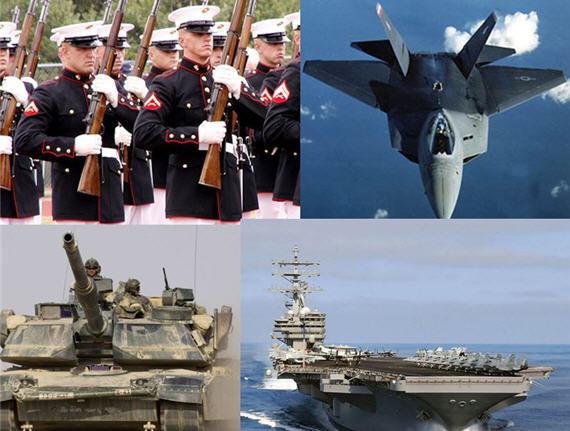
For the past six months, we led a bipartisan panel of former national security and military leaders in reviewing the document laying out the Defense Department’s plans for the next 20 years. The Quadrennial Defense Review (QDR) released this year was prepared by a Pentagon focused on responding to the threats America faces and winning the wars in which America is engaged. We had some compliments and some criticisms of the QDR, as well as suggestions for crafting a broader longer-term vision for America’s military and national power.
The issues in our report are sufficiently serious that we believe an explicit warning is appropriate. The aging inventories and equipment used by the services, the decline in the size of the Navy, escalating personnel entitlements, increased overhead and procurement costs, and the growing stress on our military forces amount to a looming train wreck in personnel, acquisition and force structure. We are confident that the trend lines can be reversed, but doing so will require an ongoing, bipartisan concentration of political will. A "business as usual" attitude toward these concerns could have unacceptable consequences for the nation.
Our review found a significant and growing gap between the military’s "force structure" — its size and inventory of equipment — and the increasingly complex and disaggregated missions assigned to it.
We deduced four enduring national interests that will continue to transcend political differences and animate American policy: defense of the homeland; assured access to the sea, air, space and cyberspace; the preservation of a favorable balance of power across Eurasia that prevents authoritarian domination of that region; and providing for the global "common good" through such actions as humanitarian aid, development assistance and disaster relief.
We identified the five gravest potential threats to those interests likely to arise over the next generation: radical Islamist extremism and the threat of terrorism; competition from rising global powers in Asia; the continued struggle for power in the Persian Gulf and the Greater Middle East; an accelerating global competition for resources; and persistent problems from failed and failing states.
It was clear to us that the military’s personnel policies demand immediate attention. While the volunteer military has been an unqualified success, its sustainability is at risk, and failure to address the increasing costs of the all-volunteer force is likely to result in reductions in the force structure, reductions in benefits, and/or a compromised force.
Our mandate from Congress and Defense Secretary Robert Gates was to make recommendations. Among our suggestions:
- Building an alternative force structure with emphasis on increasing the size of the Navy.
- Recapitalizing and modernizing the weapons and equipment inventory of all the services.
- Increasing the Defense Department’s ability to contribute to homeland defense and deal with asymmetric threats, including cyberattacks.
- Making changes in retention, promotion, compensation and professional military education — concrete proposals to be followed up on by a new National Commission on Military Personnel — that will serve the interests of service members and strengthen the volunteer force.
We remain concerned about the need for acquisition reform. Commendably, Gates has emphasized reducing the cost of new programs and the time it takes to develop them. But we are concerned that the typical direction of past reforms — expanding the process involved in making procurement decisions — may detract from the clear authority and accountability that alone can reduce cost and increase efficiency.
Our panel discussed the capabilities our government must develop and sustain to protect America’s enduring interests. Our men and women in uniform, and their families, meet our demands with undaunted courage and selfless sacrifice. While the missions falling to today’s military lend themselves to increasingly "whole of government" solutions, the civilian elements of national power — what Gates has called the "tools of soft power" — are insufficient and have been imperfectly integrated into the process. We need greater civil operational capacity to deploy civilians alongside our military and to partner with international bodies, the private sector and nongovernmental organizations in a "comprehensive approach" to dealing with failed and failing states where our interests are threatened.
Integrating the civilian agencies of our government into these efforts will require structural and cultural changes in the executive and legislative branches. We need a comprehensive strategic planning process for national security that begins at the top, integrates all elements of national power, and provides the requisite guidance to the relevant federal departments and agencies that must work together to confront this century’s challenges. Government structures fashioned in the 1940s to address the Soviet Union are disjointed and stovepiped. We need better strategic management, more holistic planning and a better crisis response for today’s world. This requires substantial change.
America remains a nation at war. Our military is rightly focused on winning those wars. Yet beyond the conflicts in Iraq and Afghanistan, the future holds opportunities and challenges unique to this century. We must help prepare the military for the long-term threats facing America and strengthen the capabilities necessary to meet those threats.
Stephen J. Hadley, a senior adviser at the U.S. Institute of Peace, was national security adviser in the George W. Bush administration. William J. Perry was defense secretary in the Clinton administration. Both are Atlantic Council Board directors. This essay was published in Sunday’s Washington Post as "What Needs to Change to Defend America."
Image: military-services-montage.jpg
